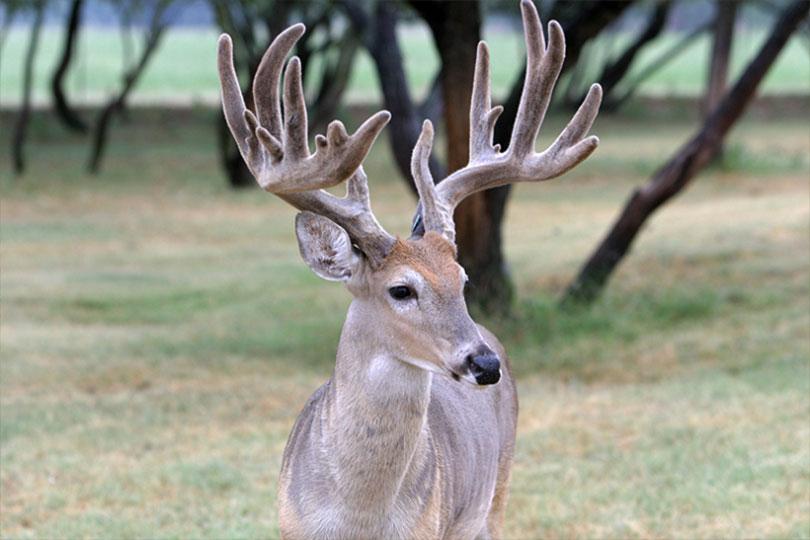By Jessica Domel
Multimedia Reporter
The Texas Parks and Wildlife Department (TPWD) could change how it establishes Chronic Wasting Disease (CWD) surveillance zones after cases of the fatal, neurological deer disease are found in deer breeding facilities.
“We are modifying our strategy as it relates to zone development and sampling at the direction of the (Parks and Wildlife) commission,” Dr. Hunter Reed, TPWD wildlife veterinarian, said at a recent commission hearing. “CWD detection solely in a captive breeding facility will see significant changes in terms of zone establishment.”
The proposed amendments, which were published in the Texas Register April 21, outline several scenarios where a surveillance zone will not be implemented if CWD is found in a breeding facility but not any of its associated release sites.
The department will not establish a zone if the following criteria are met: the disease was detected early, the transmission mechanism and pathway are known, the facility was promptly depopulated following detection, and there is no evidence that free-ranging deer populations have been compromised.
If any of those criteria are not met, TPWD will establish a CWD surveillance zone.
Surveillance zones are areas where CWD “could be reasonably expected.”
Withing these zones, the movement of live deer is restricted, and hunters are required to bring their harvested deer to a check station to be tested for CWD prior to leaving the zone.
There are also deer carcass movement restrictions to prevent the spread of CWD through tissues like the brain in CWD-susceptible deer.
The proposed amendments change the way surveillance zones are established if the above four criteria are not met.
“First, a containment zone will be established around the infected premise through a TAHC (Texas Animal Health Commission) hold order or quarantine order,” Reed said. “Then, a surveillance zone will be established two miles from the perimeter of the infected premise. All properties that are partially or wholly encompassed by the surveillance zone would be subject to mandatory testing and carcass movement restrictions.”
The surveillance zone would remain in effect until certain conditions are met.
“These conditions include: the infected deer breeding facility must be depopulated or the quarantine lifted by the Texas Animal Health Commission,” Reed said. “Second, a minimum of three hunting seasons must have passed since the date of depopulation or the lifting of the quarantine order. Third, area sampling has been completed to satisfy a 95% detection probability, and fourth, area sampling is well-distributed across the zone.”
The department is proposing nine new CWD surveillance zones across eight counties.
The new surveillance zones will be in: Gillespie, Limestone, Uvalde, Zavala, Gonzales, Hamilton, Washington and Frio counties.
Surveillance zones were established in Gillespie and Limestone county in 2022 with an emergency order after CWD was found in breeding facilities there. The emergency rule expired in March 2023.
This proposal would establish surveillance zones in both counties in accordance with the proposed rule changes.
Under the new rules, the surveillance zones in Duval, Medina, Bandera and Uvalde counties would be reduced to be consistent with the new rules.
A surveillance zone currently in place in Uvalde County would be split into two smaller zones surrounding breeding facilities where CWD has been detected. The Texas Register reports deer from those facilities were not liberated to release sites, and no additional CWD positive deer have been detected.
TPWD is also proposing an amendment that would allow them to place mandatory deer check stations outside of a surveillance zone if there is not a public location to place a check station within the zone.
The department indicates it would publicize the new check station’s location and would inform landowners.
Another change proposed by the department would allow hunters to take the head of a CWD-susceptible species—white-tailed deer, mule deer, elk—outside of a surveillance zone if a check station is not available within the zone.
This would only be allowed if the head is moved immediately, via the quickest route available, to the nearest TPWD check station.
The proposed amendment would also prescribe methods for properly disposing of a head after it has been taken to a check station for CWD testing. Hunters can take the head to a taxidermist, the property where the animal was harvested or a landfill permitted by the Texas Commission on Environmental Quality.
TPWD regulates the movement of CWD-susceptible animals and their heads because cranial and spinal tissue may be infectious, and may lead to the spread of CWD to unaffected areas of the state.
The department published its proposed amendments in the April 21 edition of the Texas Register.
Public comments may soon be submitted here.

